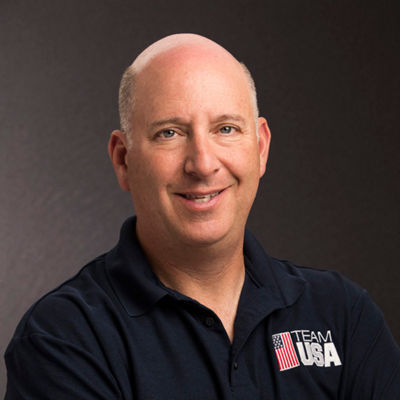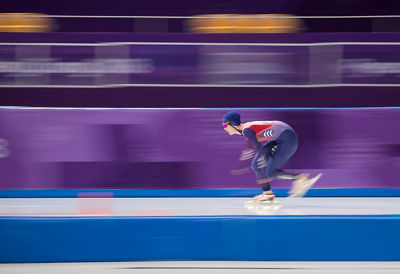The term “senior portraits” can mean different things to different people. Some people may think of portraits of senior citizens and others may think about portraits of kids who are graduating from either high school or college. In the world of professional photography, senior portraits generally refers to those who want their portraits before they graduate school. And most of the time, if they are hiring a professional photographer to take their senior portraits, they are not looking for the “cookie cutter” photo of themselves in a fake tux or dress for the yearbook. They (or their parents) are looking for a creative photo to truly show who they are.
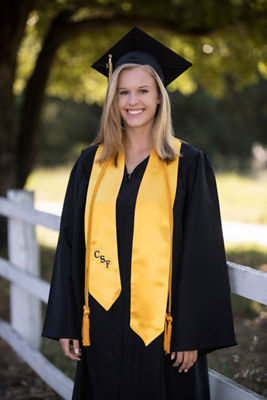
Before I take anyone’s photo, I like to get to know them a little. I want to know who they are, their interests, and what they envision for the portraits. I then suggest some locations that might work best for them. I usually schedule these portrait sessions weeks or months in advance and, if shooting outdoors, I like to aim for late morning or early evening to get the most flattering light on my subjects. It is during those times when the sunlight is more golden in color and also more directional. This directional light lets me place my subject facing the light or facing away from the light, while being evenly lit in the process. It also makes it easier for me to find nice shaded areas for my backgrounds.
When choosing a location, there should be a couple of things to keep in mind:
- Does the location match the subject? In other words, you probably don’t want to have a big football player posed in front of pretty flowers, or the girl who likes pretty conservative outfits to be posing in leather against a graffiti wall.
- How is the light at this location? We all know that good light is critical to making good images. I prefer to shoot in locations that have great backlight and nice shady areas to give me plenty of options.
This photo was taken in my back yard, taking advantage of the late afternoon golden sunlight. We had completed our senior portrait session and returned to my house. As her mother was talking to my wife, I looked outside and saw the last light on the flower bed. I asked this young lady if she wanted to do a couple more photos, and she was open to it. I am so glad we did.
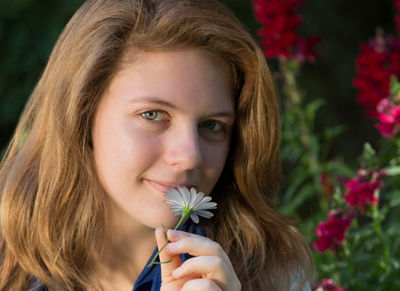
This photo was taken at a local park. I had this young lady turn so that the sun was backlighting her, and used my Canon 600EX-RT flash to fill her with light from the front. I had the flash mounted directly on the camera, and in E-TTL mode. I powered the flash down by one stop (-1) using flash exposure compensation so that I would get catchlights in her eyes, but keep the photo from looking overly “flashed.” I used the tree branches to create a frame around her, drawing the viewer’s eyes to her face.
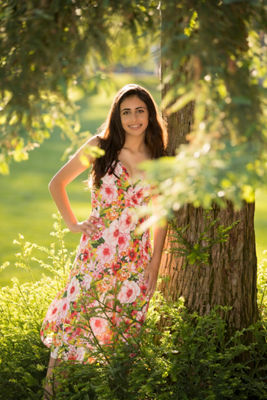
For cameras, I usually opt for my Canon EOS-1D X Mark II or my Canon EOS 5D Mark IV camera bodies since they focus so fast and provide exceptional image quality. Since the EOS-1D X Mark II has a shutter release button in both the portrait and landscape positions, I often use that camera for portraits, as it is easier to control from any position. Even though I have many Canon lenses, I almost always default to my Canon 70-200mm f/2.8 IS II USM lens due to its exceptional sharpness and beautiful depth of field.
The 70-200mm lens is so sharp and the focal range so flattering, that I always trust this lens to get awesome photos of my clients. I love that I can stand back from my subjects (giving them some space) but zoom in to get some beautiful tight shots with awesome bokeh in the background. I typically shoot between 150mm and 200mm and at apertures between f/2.8 and f/4. This combination gives me great separation between my subject and the background. When people look at photos, their eyes are drawn to the areas of sharpest focus, which is why I strive to have my subject tack sharp and my background silky smooth.
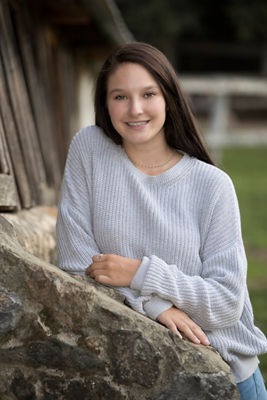
As much as I love my 70-200mm lens, I may opt for a couple of other lenses, depending on composition and what I am trying to show.
I was shooting some edgy photos of this young man with the Canon 70-200mm, when he asked me if I could get some photos of him jumping. I knew that the mid-range zoom would not be ideal for this, and that it would require a different lens to get the effect I wanted.
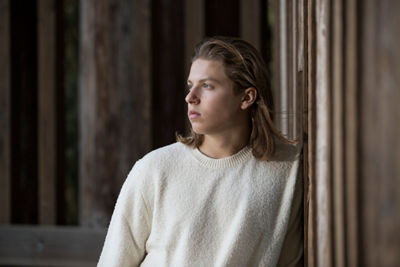
I switched to the Canon 16-35mm f/2.8L III USM lens and got down low to the ground. He climbed a nearby wall and I took this wide shot of him. I chose the low shooting angle to help exaggerate the height of his jump. I also used my Canon 600-EX-RT Speedlite (on camera) to light him for this photo. Since my shutter speed was 1/1600th sec, and the Canon flash cannot sync with the camera at that speed, I had switched the flash to High-speed Synch mode. In standard E-TTL mode, you must have a shutter speed of 1/250th sec or slower on the EOS-1D X Mark II or 1/200th sec or slower on the EOS 5D series for the flash to work correctly, but by switching to High-speed Synch mode, you can use the flash with shutters speeds as fast as 1/8000th sec. This allows me to take control of the background intensity by raising the shutter speed for darker backgrounds and lowering it for lighter backgrounds.
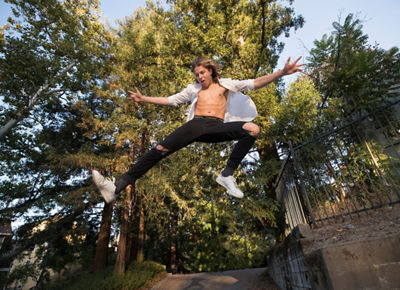
I talked to this young man before shooting his senior portrait and he told me that baseball was hugely important to him. I knew that we had to get some photos of him in his high school baseball uniform, but before doing so, we both decided that it would be better to start with formal images at Stanford University. I found this location with a really nice repeating pattern of the columns, and had him stand there for a photo. As is true for any portrait, the composition is very important. Once again, using the Canon 70-200mm lens, I chose not to photograph him dead center, but to offset him so that the leading lines of the column would draw you to him.
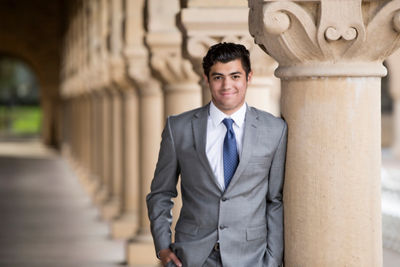
Some photographers will say that a fisheye lens should never be used for portraits, but I love trying new things and breaking the rules. I took some photos of him on the field, but felt that they were uninteresting. Just before finishing the photo session, I suggested that we try something different. I switched to the Canon 8-15mm fisheye lens and asked my subject to rest on the nearby fence. I got in close to him, which exaggerates the size of the glove and took this photo. It is still one of my favorite senior photos, partially because it is unique and partially because it shows so much of who this young man is.
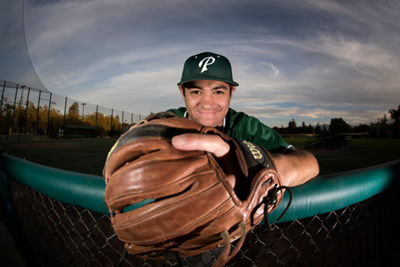
As is true for almost all photography, lighting is critical to making a nice image. Since most of senior portraiture is photographed outside in ambient light, I like to use a combination of that ambient light mixed with the light from my Canon 600EX-RT Speedlites.
In order to keep my photos from looking over “flashed,” I usually turn down the power of my flash by at least one stop (in E-TTL mode) using flash exposure compensation. Even though I have reduced the power of the flash, there is enough light emitted to lightly fill in any shadows on the face and add that critical catchlight to their eyes.
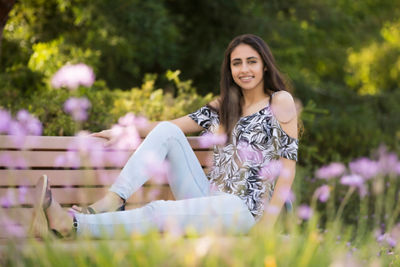
Look closely and you will see that many of my seniors are leaning on something, whether it’s a tree, a fence, a column. This is a pose that I use quite often. It gives the subject a more relaxed pose and even gives them a natural place for their hands. When we get to a good location, I usually ask the senior to rest against the object, but I don’t always tell them how. I like to see how they would do it without my direction. Many times this will give me a better chance of grabbing a portrait of them looking very relaxed and have a better chance of capturing who they are.
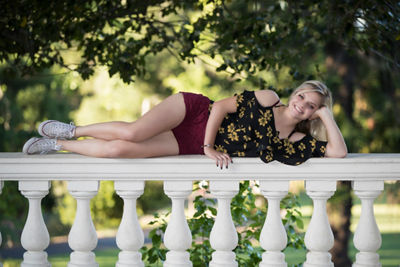
This leads me to the most important part of the senior portrait shoot. My goal for every portrait session is to capture the essence of the subject in front of the camera. Remember, this photo shoot is not about me, it is about the senior. Each person is different and I love the challenge of finding out who they are and how to show that in a photo. After all, as photographers, we are always striving to tell a story. In this case, the story is about this graduating senior who is about to take on the next step in their lives.
Lastly, I would like to leave you with some senior portrait tips:
• Make sure that your senior portraits are age appropriate, both in outfits and poses.• Don’t go crazy with retouching. Even though I do remove acne and other distractions, I try not to go overboard on the skin smoothing.• Control your time so that you keep it to two hours or less. After that, your subject will likely tire out.• Try using more than one Canon Speedlite to create more dynamic lighting. I will often ask one of their parents to hold an off-camera flash for me.




